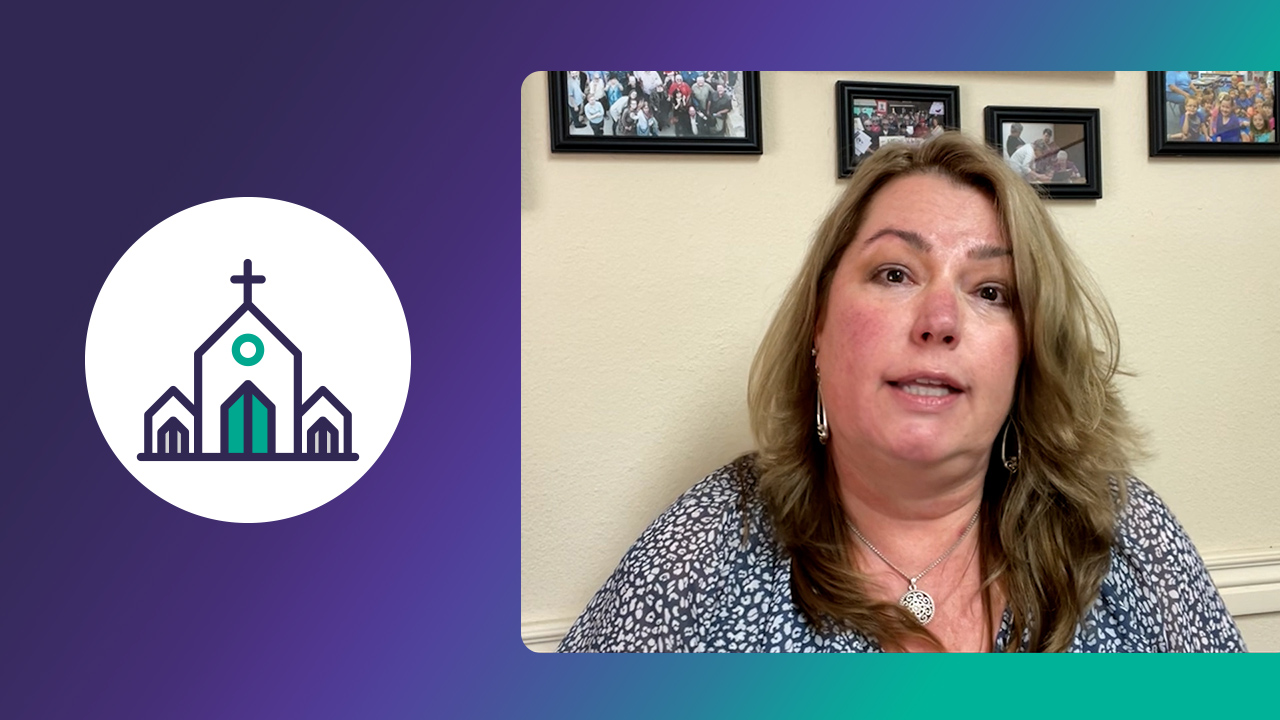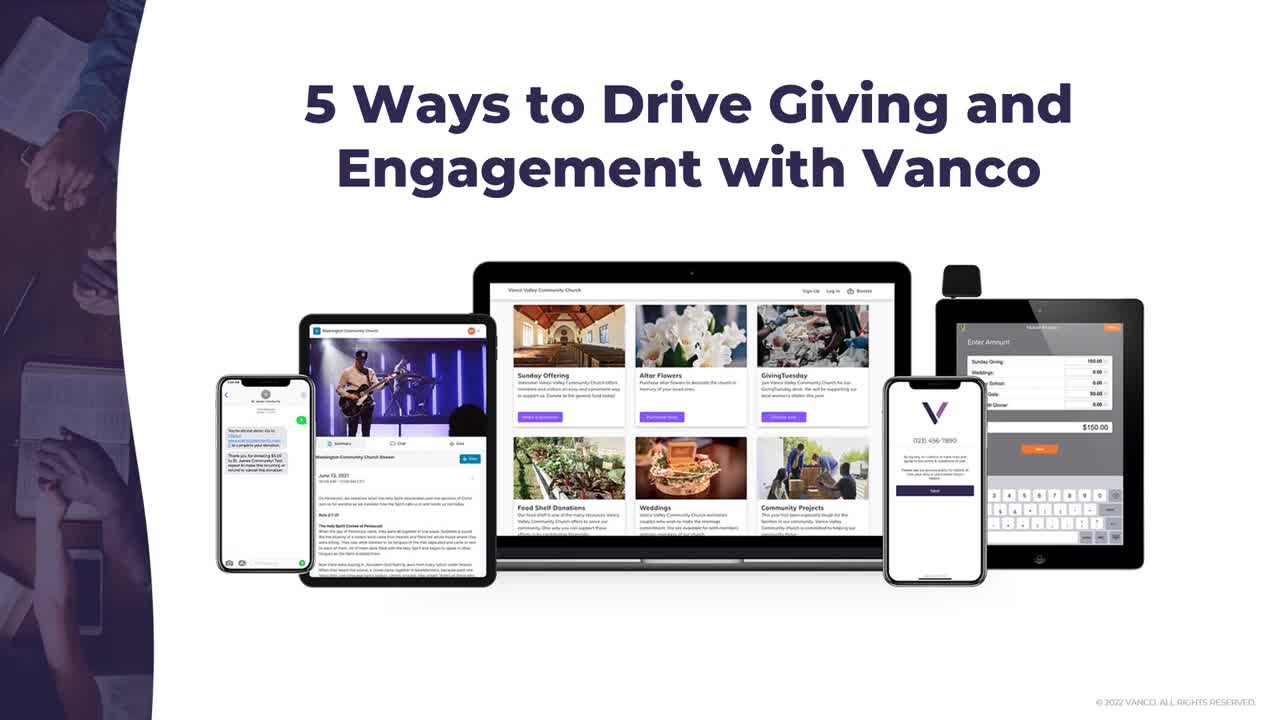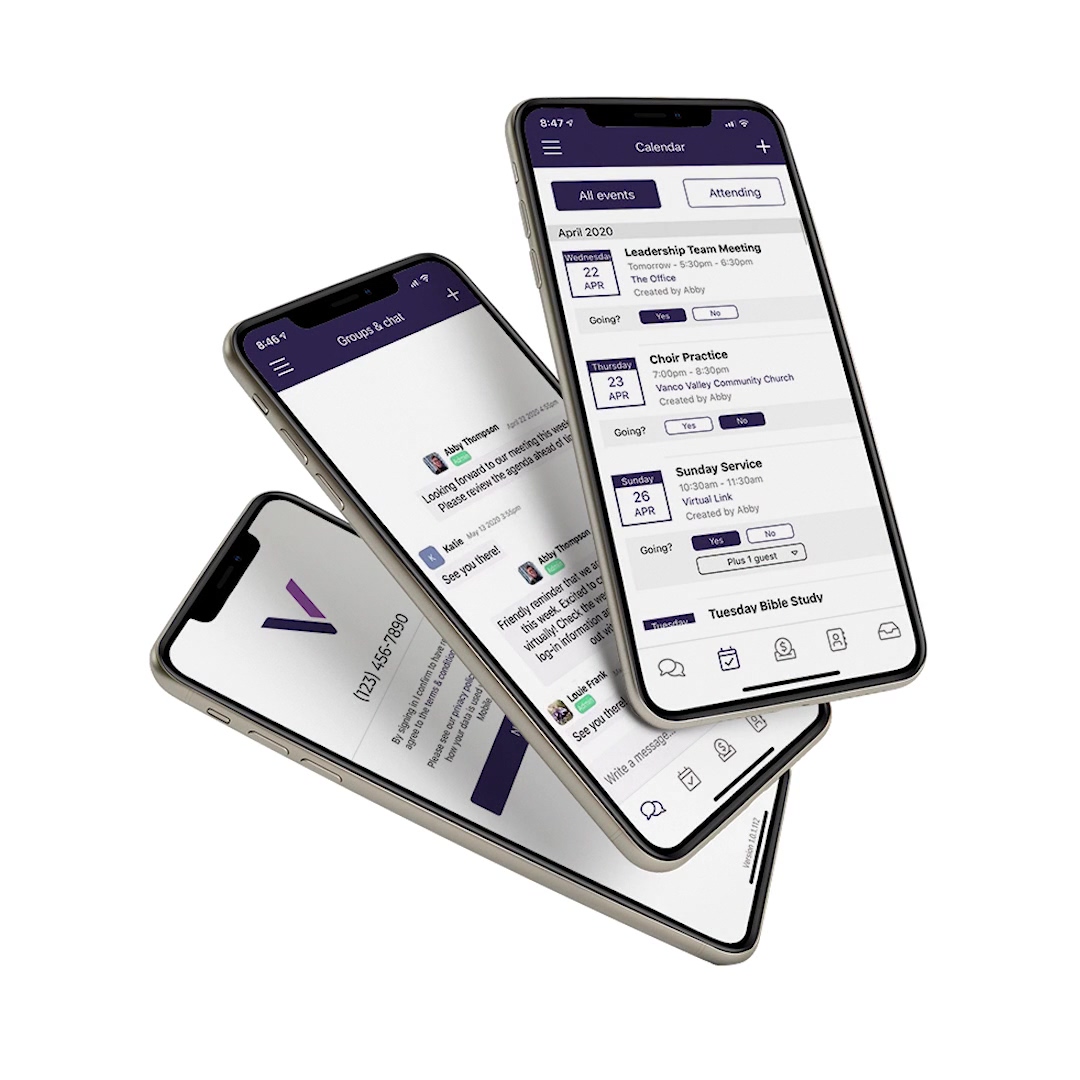
Being a church leader today means more than preaching and guiding your congregation. With so much happening online, even generosity has gone digital. So why are so many churches still hesitant to embrace it?
Faith-based leadership in the digital age isn’t about keeping up with trends; it’s about removing barriers to generosity and ensuring your church remains strong for years. Church leadership and giving go hand-in-hand, so understanding these topics is essential.
Table of Contents
What Is Ministry Leadership in Today’s Context?
Challenges Faced by Modern Ministry Leaders
How Digital Donation Tools Support Ministry Goals
Key Features to Look for in Donation Tools
How Ministry Leaders Can Lead the Digital Giving Transition
Why Vanco Is a Trusted Choice for Ministry Leadership
Too Busy to Read? Listen to the Key Takeaways
Get the key takeaways by clicking to listen the podcast summary now!
What Is Ministry Leadership in Today’s Context?
.jpg?width=588&height=392&name=School%20office%20worker%20about%20to%20take%20notes%20on%20finances%20(2).jpg)
Ministry leadership is much more than delivering a great sermon on Sunday. Sure, it would be nice if it were that simple, but today, you’re:
- Leading a team
- Managing finances
- Coordinating volunteers
- Make sure the lights stay on
- Keeping your congregation engaged spiritually.
It’s a role that requires wisdom, patience and a surprising amount of organizational skills. People look to you not just for guidance in faith but for direction in how the church operates.
You’re balancing pastoral care with church administration, ensuring that programs run smoothly and keeping up with the evolving ways people want to connect. It’s not just about maintaining traditions, but also finding ways to keep your ministry relevant and impactful.
Key Responsibilities That Now Intersect With Tech and Giving
Technology is changing how people interact with their faith, including how they give. More people prefer to donate online, engage through apps and stay informed via digital channels.
As a result, digital ministry leadership now includes integrating modern ministry tools that make it easy for your congregation to contribute, stay involved and grow in their faith. The days paper checks and cash donations are fading quickly, although some in older generations still prefer them.
Churches that embrace online donation platforms and digital communication tools tend to see more consistent engagement. Having a system that allows recurring giving, sends reminders and provides financial transparency can take a lot of stress off your plate while strengthening your church’s financial health.
Your leadership responsibilities today aren’t just about delivering a message; they’re about ensuring your ministry is equipped for the future. That means embracing technology in a way that feels natural, helpful and aligned with your mission.
Challenges Faced by Modern Ministry Leaders
You know that generosity is at the heart of a thriving church, but getting people to give consistently is more challenging than it used to be. Your congregation is constantly asked to donate to online fundraisers, nonprofit campaigns and crowdfunding requests.
The challenge isn’t just asking for support; it’s making sure people see the value and impact of their giving. The good news? People want to give to causes they believe in.
The challenge is keeping them engaged without overwhelming them. Regularly sharing how donations are making a difference, offering flexible giving options and making generosity a natural part of church culture all help. However, tracking engagement and maintaining consistent giving can feel like a full-time job without the right tools.
Administrative Overload
Let’s talk about paperwork. You didn’t go into ministry to spend hours on financial spreadsheets, donation tracking or event logistics, but somehow, these tasks take up more time than you’d like.
Ministry leadership today means balancing pastoral duties with administrative work and honestly, it can be exhausting. If you’re feeling stretched thin, you’re not alone.
Many church leaders experience burnout from trying to do everything themselves. The key is finding church tech adoption strategies that help automate the tasks that drain your time, like donation tracking, financial reporting and volunteer coordination.
Keeping Up With Tech Adoption
The digital world isn’t slowing down, nor are people’s expectations. From live-streamed services to online donation tools for churches, technology is shaping how ministries connect with their communities. The challenge is figuring out what’s worth investing in and what’s just another thing to manage.
Some church leaders worry that technology will make ministry feel less personal. But the reality is that the right tools can free you up to focus more on people. When giving is seamless, communication becomes clearer and administrative work is streamlined, you have more time to do what truly matters: shepherding your congregation and growing your ministry.
How Digital Donation Tools Support Ministry Goals
If there’s one thing ministry leaders know, generosity thrives when giving is simple and according to the numbers, that’s what digital giving provides. Research shows that recurring givers donate twice as much as one-time givers.
Church leadership ministers are increasingly embracing digital platforms to streamline the process of accepting donations from churchgoers. Numerous ministries have seen a significant increase in donations by implementing digital tools like Vanco. One such church, CDO, was able to increase its recurring givers by 10X, helping them to grow their mission to reach 500 souls within their community.
Why? Because when giving is automatic, it becomes a consistent act of faith rather than an occasional decision. Churches that have embraced online donation tools are seeing undeniable results.
Our benchmark study of 25,000 churches found that online giving grew by 159 percent over five years. Another survey of 1,000 churchgoers confirmed that many prefer digital giving because it’s faster, easier and fits their lifestyle. If your church hasn’t fully embraced online giving, you might be leaving valuable support on the table.
If you're looking for more information on the topic, Check out Heidi's story to see how Vanco's online tools helped create an impact for her church.

The Flexibility of Church Giving
Your congregation isn’t one-size-fits-all and neither should your giving options be. Church tech adoption has made it possible for people to donate in the way that works best for them, whether through a mobile app, text-to-give, an online portal or even a kiosk in the church lobby.
Removing obstacles to giving means more people can contribute consistently, no matter how or when they choose to give.

Learn More About Online Giving.
Real-Time Reporting and Financial Visibility
Ministry leaders don’t have time to guess where donations stand. That’s where digital ministry leadership makes all the difference. Real-time reporting lets you track giving patterns, plan your budget confidently and keep your church finances transparent.
Better Connection With Tech-Savvy Generations
If younger generations don’t always carry cash, how can they give? The answer is simple: digital options. Faith-based leadership in the digital age means meeting people where they are on their phones, tablets and computers. More people can actively support the church’s mission when giving is effortless, regardless of age or tech preferences.
Key Features to Look for in Donation Tools
Mobile and Recurring Giving
Let’s be honest; everyone expects convenience these days. If it’s not easy, people won’t use it. The same goes for giving. A mobile-friendly platform allows your congregation to give in seconds, whether sitting in a pew, watching online or remembering midweek that they forgot to tithe.
Recurring giving? That’s a game-changer. People want to give, but life gets busy. Setting up an automatic donation removes that barrier and churches with strong recurring giving programs see double the contributions compared to those relying on one-time gifts.
Key features to look for include an intuitive design, mobile compatibility and robust security. A user-friendly interface makes it easier for congregants to donate, while multiple payment options (credit cards, digital wallets, etc.) ensure all members can participate.
Watch this short video below to see how mobile giving can strengthen generosity and engagement.

Want to Learn More About Church Mobile Giving?
Integration with church systems
Ministry leaders already juggle a lot. Manually tracking donations shouldn’t be one of those things. A great giving tool connects seamlessly with your church management software, syncing contributions with member records, budgets and reports. Church tech adoption should make life easier, not add extra work.
Vanco integrates with 60+ church management systems, saving you time and effort. See how it works.
Donor data insights and tracking
Understanding giving trends helps you plan for ministry growth. You can tailor your communication and stewardship efforts when you can see who gives, how often and what methods they prefer. Faith-based leadership strategies in the digital age aren’t just about inspiring generosity; it’s about using data to nurture it.
Vanco provides real-time donor insights. Explore our powerful tracking tools here.
PCI compliance
No one likes talking about cybersecurity until a breach happens. Data breaches can cost millions of dollars and churches are as vulnerable as any organization. In fact:
- Verizon’s Data Breach Report shows that nearly half of all breaches involve financial data.
- PCI compliance failures have led to massive fines and severe reputation damage.
Vanco meets PCI compliance standards, keeping your church’s financial data secure.
How Ministry Leaders Can Lead the Digital Giving Transition
Communicate Clearly with the Congregation
People are more likely to embrace change when they understand why it’s happening. Before rolling out online donation tools for churches, talk openly about the benefits.
Digital giving isn’t replacing traditional offerings; it’s making generosity easier. It allows families to give consistently, even when they miss a Sunday service. It provides financial stability for the church, helping ministries thrive year-round and yes, it’s secure, just as safe as paying a bill or shopping online.
Don’t just announce digital giving once and hope it sticks. Reinforce the message through sermons, newsletters and personal conversations. If someone has questions, take the time to listen. The more approachable you make this transition, the smoother it will be.
Use Giving Tools as Part of Vision Casting
People don’t give to platforms; they give to purpose. When introducing digital giving, connect it to the church’s bigger picture. Whether you’re launching a new outreach program, supporting missions or simply keeping the lights on, show how every contribution makes a difference.
Leading a generous church means making giving accessible while reminding people why generosity matters. Digital tools for ministry aren’t just about convenience; they’re about sustaining the ministries and programs that change lives.
Involve Leadership Teams and Provide Training
Ministry leaders need to be proactive in training their staff and volunteers. This ensures they can guide congregants through the transition confidently and can answer any questions that arise.
A transition like this works best when leadership is entirely on board. Before launching digital giving, ensure your staff and key volunteers understand how it works. Give them hands-on experience so they can confidently answer questions. If someone is unsure how to use the platform, they should know who to ask for help.
You don’t need to be a tech expert to lead this transition, but you need to create an environment where people feel supported. Faith-based leadership in the digital age isn’t about having all the answers. It’s about guiding your church forward with confidence, clarity and a little bit of patience.
Why Vanco Is a Trusted Choice for Ministry Leadership

Choosing a digital giving platform is a big decision. You need a system that’s reliable, easy to use and designed with churches in mind. That’s precisely why thousands of ministries trust Vanco. It’s built for churches by people who understand how churches operate.
Proven Growth in Church Giving
Churches that switch to Vanco see actual results. Our study of 25,000 churches found that online giving increased by 159 percent over five years. That’s not just a tiny bump; it’s a transformational shift. Digital giving isn’t a trend; it’s a tool that helps churches sustain and grow their ministries. See the study here.
Designed for Faith-Based Organizations
Vanco isn’t just another payment processor; it’s a platform built specifically for churches. It integrates with over 60 church management systems, offers mobile and text giving and provides real-time financial insights. That means less time worrying about administrative work and more time focusing on ministry.
If you’re embracing digital ministry leadership, you need tools that work exactly how your church does. Vanco was built with that in mind.
Scalable Solutions for Churches of All Sizes
Whether you serve a congregation of 50 or 5,000, Vanco grows with you. It offers flexible pricing, secure transactions and support from a team that understands church operations. As church tech adoption continues to rise, having a giving platform that adapts to your needs is crucial.
Talk to a Giving Coach
Switching to online giving is a big step; you don’t have to do it alone. Our experienced giving coaches help you determine what works best for your church. Ask your questions and see how online giving can grow your ministry. Request a demo today.
FAQs
What is ministry leadership in a digital context?
Ministry leadership now involves managing technology, finances, and engagement. Embracing digital tools enables church leaders to connect with their congregation beyond Sunday services and streamline operations.
How can donation tools help ministry leaders?
Online donation tools reduce financial stress, encourage consistent generosity, and simplify donation management, allowing leaders to focus on spiritual guidance and community engagement.
How do I introduce online giving to my congregation?
Start small and communicate the benefits clearly. Emphasize how digital giving supports your church's mission and makes generosity more accessible for everyone, regardless of attendance.
Is it worth investing in donation tools for smaller ministries?
Yes. Regardless of size, every church can benefit from the accessibility, consistency, and convenience that digital giving tools provide, making it easier for every member to contribute.
What are the benefits of digital donation tools for ministry leadership?
-
Accessibility: They offer an easy, convenient way for people to donate, especially for those who don't carry cash.
-
Data Tracking: Provides insights into giving patterns to measure success and adjust strategies.
-
Broader Reach: Expands fundraising potential by enabling donations from anywhere, not just local congregants.
How do digital giving platforms ensure the security of donations?
Platforms like Vanco ensure donation security through SSL encryption, two-factor authentication, PCI DSS compliance, and regular security audits, giving donors peace of mind.
Can digital donation tools integrate with existing church management software?
Yes, the right digital giving platform seamlessly integrates with church management systems, improving efficiency and providing a comprehensive solution for donation tracking and reporting.
How can we encourage our congregation to transition to online giving?
Educate your congregation about the benefits of online giving, provide testimonials of its success, and reassure them about security. Consistent communication and reminders will help ease the transition.
What features should we look for in a digital giving platform?
Look for platforms that offer:
-
A user-friendly interface
-
Multiple payment options, including recurring donations
-
Strong security features
-
Mobile compatibility
-
Reliable customer support and proven success with other churches.
Free Church Leadership Guide to Advance Your Unique Mission
Our team painstakingly gathered the data, best practices and strategies your church's leadership team needs, organizing them into this essential and free eBook.
Download our free eBook to learn…
- What to avoid.
- How to set SMART goals.
- Leadership model structures to inspire your church leadership strategy.
- How to recruit volunteers and delegate.
- How to handle challenging situations such as disgruntled church members or staff.
- How to be a good financial steward for your church.
- And more!













